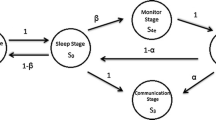Abstract
For production of transient voltage output in wireless sensor network, due to the instability of the control voltage, the traditional control method needs to introduce the feedback control, through the establishment of mathematical model for periodic monitoring of the output voltage, change control strategy once the problem is found, lead to slow control time computation, cannot obtain the optimal output voltage values. A new method for calculating transient optimal voltage output points in sensor network of two-phase rotating and stationary coordinates is proposed. Through the analysis of the mathematical model of the network transient, the repetitive controller is designed on the two axes. By calculating the mean value of maximum and minimum value of the voltage, the transient energy-saving voltage output of the sensor network is monitored in real time. The control process of output voltage quality of sensor network with nonlinear load is analyzed, and the feed forward control method of parameter on line control is put forward. Under the premise to meet the control accuracy, enhance the response speed and stability of voltage output control of sensor networks. Simulation results showed that the method presented in this paper improves the poor effect of traditional methods, solves the complex problems of network energy-saving voltage control, and control effect of energy-saving voltage output is great, and the optimal voltage output values is obtained.







Similar content being viewed by others
References
Ren Z, Peng S, Chen H, Fang J, Chen Q (2013) Epidemic routing based on adaptive compression of vectors: efficient low-delay routing for opportunistic networks based on adaptive compression of vectors. Int J Commun Syst 28:560–573
Hiertz GR, Denteneer D, Max S, Taori R, Cardona J, Berlemann L, Walke B (2010) IEEE 802.11s: the WLAN mesh standard. Wirel Commun IEEE 17(1):104–111
Hao J (2015) Image processing and transmission scheme based on generalized Gaussian mixture with opportunistic networking for wireless sensor networks. HCIS 5:226–228
Manhas Jr EB, Brante G, Souza RD, Pellenz ME (2012) Energy-efficient cooperative image transmission over wireless sensor networks. In: Proceedings of 2012 IEEE wireless communications and networking conference (WCNC), pp 2014–2019
Ngau CWH, Ang L-M, Seng KP (2012) Low memory visual saliency architecture for data reduction in wireless sensor networks. IET Wirel Sensor Syst 2(2):115–127
Lecuire V, Duran-Faundez C, Krommenacker N (2008) Energy-efficient image transmission in sensor networks. Int J Sensor Netw 4(1–2):37–47
Muhammad Imran Razzak SA, Hussain AA, Minhas MS (2010) Collaborative image compression in wireless sensor networks. Int J Comput Cogn 8(1):24–29
Lu Q, Luo W, Wang J, Chen B (2008) Low-complexity and energy efficient image compression scheme for wireless sensor networks. Comput Netw 52(13):2594–2603
Carrano RC, Magalhaes LCS, Saade DCM, Albuquerque CVN (2011) IEEE 802.11s Multihop MAC: a tutorial. Commun Surv Tutor IEEE 13(1):52–67
Liu X, Huang L, Li J, Wang Z, Zhao D, Zhu M (2012) Image transmission over ZigBee-based wireless sensor networks. Sensors Lett 10(1–2):205–212(8)
Pham DM, Aziz SM (2013) Object extraction scheme and protocol for energy efficient image communication over wireless sensor networks. Comput Netw 57(15):2949–2960
Aziz SM, Pham DM (2013) Energy efficient image transmission in wireless multimedia sensor networks. IEEE Commun Lett 17(6):1084–1087
Viegas CMD, Sampaio S, Vasques F, Portugal P, Souto P (2012) 9th IEEE international workshop on factory communication systems (WFCS). Assessment of the interference caused by uncontrolled traffic sources upon real-time communication in IEEE 802.11-based mesh networks, pp 59–62
Irgan K, Ünsalan C, Baydere S (2014) Low-cost prioritization of image blocks in wireless sensor networks for border surveillance. J Netw Comput Appl 38:54–64
Nikolakopoulos G, Kandris D, Tzes A (2010) Adaptive compression of slowly varying images transmitted over wireless sensor networks. Sensors 10(8):7170–7191
Liu L, Song Y, Zhang H, Ma H, Vasilakos AV (2015) Physarum optimization: a biology-inspired algorithm for the Steiner tree problem in networks. IEEE Trans Comput 64(3):818–831
Kaddachi ML, Soudani A, Lecuire V, Torki K, Makkaoui L, Moureaux JM (2012) Low power hardware-based image compression solution for wireless camera sensor networks. Comp. 10.1186/s13638-015-0458-3 Moureaux Low power hardware-based image compression solution for wireless camera sensor networks. Comp Stand Interfaces 34(1):14–23
Zhang XM, Zhang Y, Yan F, Vasilakos AV (2015) Interference-based topology control algorithm for delay-constrained mobile ad hoc networks. IEEE Trans Mob Comput 14(4):742–754
Duarte PBF, Fadlullah ZM, Vasilakos AV, Kato N (2012) On the partially overlapped channel assignment on wireless mesh network backbone: a game theoretic approach. IEEE J Sel Areas Commun 30(1):119–127
Imran N, Seet BC, Fong ACM (2015) Distributed video coding for wireless video sensor networks: a review of the state-of-the-art architectures. HCIS 4:513–515
Elamin A, Jeoti V, Belhouari S (2012) Wireless video sensor networks: advances in distributed video coding. In: Ang L, Seng KP (eds) Visual information processing in wireless sensor networks: technology, trends and applications. IGI Global, Hershey, pp 40–58
Imran N, Seet BC, Fong ACM (2012) A comparative analysis of video codecs for multihop wireless video sensor networks. Multimed Syst 18(5):373–389
Liang CJM (2011) Interference characterization and mitigation in large-scale wireless sensor networks. Dissertation, John Hopkins University,
Magaiaa N, Hortab N, Nevesb R, Pereira PR, Correiaa M (2015) A multi-objective routing algorithm for wireless multimedia sensor networks. Appl Soft Comput 30:104–112
Liu S, Cheng X, Fu W et al (2014) Numeric characteristics of generalized M-set with its asymptote. Appl Math Comput 243:767–774
Liu S, Fu W, He L et al (2015) Distribution of primary additional errors in fractal encoding method. Multimed Tools Appl. doi:10.1007/s11042-014-2408-1
Liu S, Zhang Z, Qi L et al (2015) A fractal image encoding method based on statistical loss used in agricultural image compression. Multimed Tools Appl. doi:10.1007/s11042-014-2446-8
Acknowledgments
The national natural science foundation of China (61472268); Suzhou science and technology support plan (SS201336)
Author information
Authors and Affiliations
Corresponding author
Rights and permissions
About this article
Cite this article
Gu, C., Caidong, G.U. & Ling, F. Calculation and simulation of transient optimal voltage output point in wireless sensor networks. J Supercomput 72, 2767–2781 (2016). https://doi.org/10.1007/s11227-015-1605-7
Published:
Issue Date:
DOI: https://doi.org/10.1007/s11227-015-1605-7




